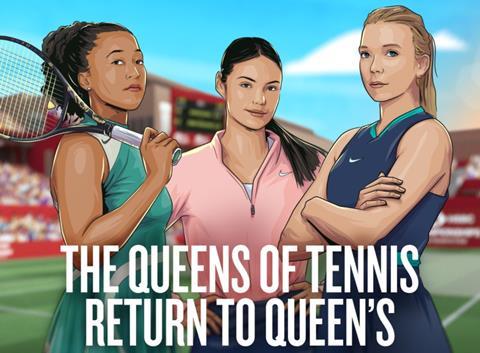With a women’s tournament joining the competition for 2025, the LTA has produced a range of content promoting women’s tennis players

The Queen’s Club Championships has long been a prelude for the men’s Wimbledon tournament, but for 2025 it will also welcome some of the top women’s tennis players for the first time since 1973.
With this in mind, the LTA, the national governing body for tennis in the UK, worked with media agency The Kite Factory to produce The Queens Of Tennis campaign across TV, Out Of Home, social media and digital channels, focusing on top women’s players Emma Raducanu, Naomi Osaka and Katie Boulter. It has partnered with The Kite Factory since 2019.
With the tagline ‘The Queens of Tennis Return to Queen’s’ this latest creative saw the players rallying a ball across a digitally recreated London skyline before landing it in the iconic Queen’s Club, symbolising the return of elite women’s tennis to this historic venue.
Jo Walsh, senior brand marketing manager at LTA and Anthony Abou-Zeid, managing partner at The Kite Factory, reveal more about the campaign.
Q: What were you trying to achieve with this campaign?

Abou-Zeid: “Women coming back to Queen’s for the first time since 1973 is headline news in the tennis - and indeed sporting - world, so first and foremost the LTA wanted to make a splash about that, particularly at a time when women’s tennis is so well represented in the UK.
“A landmark moment like this presents a perfect opportunity to create more buzz around tennis - for people who don’t know much about sport; plus the women’s game - for existing fans who traditionally follow the men’s game; and Queen’s - for tennis enthusiasts who maybe focus more on the Grand Slams.
“However, our founding insight wasn’t just about fueling the sport or the competition, it was about using icons of the game to raise awareness of the expansion of one of London’s most iconic sporting events
“Tennis is in a fortunate position where the popularity of the women’s game is strong and growing. The WTA hit a one billion viewership milestone in 2023, and viewership of women’s Grand Slam finals matches is fairly equal against the men’s game.
“What we found interesting was the growth in live tennis viewership. In the UK, this was driven by female viewers who were up 31% compared male viewers who increased 14%. Meanwhile, Millennials and Gen Z account for 41% of viewership, showing that brand ‘tennis’ is in good health.”
Q: Why now?

Walsh: “We’re in the midst of a significant moment for women in sport. Tennis has led the way for women’s sport over many years and this only continues to grow - in particular we’re seeing a real moment for British tennis, with several players having success at the highest level. Add to that the experience of other sports, particularly football and cricket, where the women’s teams are now stepping into the spotlight, and you can see this is an opportunity to harness the momentum and inspire women of all ages across all of sport. The return of women’s tennis to Queen’s was the perfect opportunity for us to authentically amplify the key role women’s tennis plays in the grass court season and inspire new fans to the event.”
Q: How does this complement the most recent advertising from LTA?
Abou-Reid: “Since we’ve started working with the LTA the campaigns have focused on participation, and breaking out beyond conventional audiences. Play Your Way, which launched in 2020, was all about inviting anyone and everyone to pick up a racket and bring their game to the court, while the Tennisables in 2023 introduced characters Ace, Bounce, Dash, Slice, Smash and Spin to appeal to younger children showcasing the playful nature of tennis and the many skills it offers. Although we have previously run ticketing campaigns, Queens of Tennis is the first campaign that is focused on driving audiences to engage with the sport at a professional level whilst still driving wider awareness of the sport. Using famous players ensures that mass appeal and like our previous campaigns with the LTA we always want to widen the appeal and engagement with tennis and tackle the perception it is a closed sport.”
Q: Is women’s tennis moving into the same league as the men’s game as far as audiences are concerned?
Walsh: “Women’s tennis has always had a strong following but the upward trend is certainly what we’re seeing. Emma Raducanu winning the US Open in 2021 marked a real moment for the women’s game in the UK. She is one of our greatest success stories, having started out as a junior and worked her way up through our pathway to the very top of the sport.
“Having a homegrown success in any sport gives the opportunity to draw in new fans and everything that’s happened since then is all part of that momentum. Now we’re bringing world class female players from across the globe to a British tournament gives us that stage to broaden the visibility of the elite women’s game and engage future audiences.
Q: How does the latest campaign help sell tickets?
Abou-Zeid: “It’s all about building awareness and excitement for the event. The HSBC Championships at The Queen’s Club are well known among tennis supporters but with the event being new this wouldn’t necessarily be something our target audience of female sports fans and live event fans would be aware of. So while the end goal is to encourage people to engage with the event and purchase tickets, it’s as much about the buzz and getting consideration from new fans, whether that be at the event or watching it on TV over the summer.
“We’ve seen a similar direction taken in the past few years with The Hundred, for example, which very much aimed its marketing at families, to great effect, so we knew there was an appetite for live sport among that demographic. If we can reach young people and their parents now, and capture the imagination early, there’s a strong chance we’ll ignite a lifetime passion for the sport.”
View this post on Instagram
Q: How did you prepare to produce the campaign?
Abou-Zeid: “We knew we had a clear advantage with tennis — female tennis players have a strong precedent for attracting strong audiences at key tournaments, such as the 2019 Wimbledon final between Serena Williams and Simona Halep (which drew a larger audience than the men’s final).
“We set about analyzing the audience into three segments: players, TV viewers, and live attendees. What quickly became clear was that, although younger cohorts within our target audience are the fastest-growing group for tennis viewing – they were less likely to be aware and therefore less engaged with women’s tennis at HSBC Championships at The Queen’s Club than older audiences, both male and female.
“We recognized an opportunity to inspire and engage a younger audience — and knew that if we were successful, we could reap the benefits of this group sticking with tennis into adulthood. This is both beneficial in the short term as it meant greater attendance and viewership of the tournament but also in the long term from a lifetime value perspective.”
Q: HSBC’s logo is featured in the campaign. Can you talk about their involvement and other brand partnerships?
Walsh: “As the new title partner of the tournament the LTA and HSBC have worked closely together across the creation of the ad. Ultimately the LTA’s goal is to increase the visibility and accessibility of tennis, particularly of the women’s game, with HSBC helping us reach new audiences. HSBC has a long-standing commitment to world class sport, including its brand ambassador partnerships with former British No.1 Tim Henman and 2021 US Open Champion Emma Raducanu so having a sponsor that is trying to achieve the same goals is essential to drive an authentic partnership.”
Q: What other activity can we expect to see around this campaign?
Walsh: “As we get closer to the event and more athletes get announced we will be looking to create some key PR moments and bring the tournament to life in place people may not expect – so watch this space.”




No comments yet